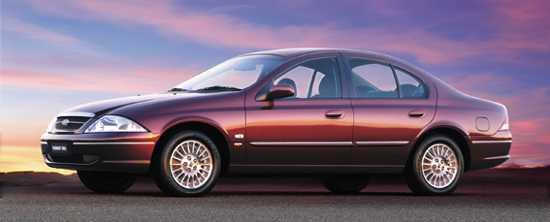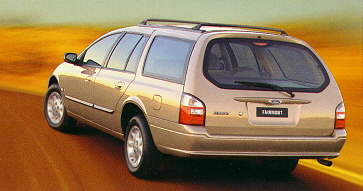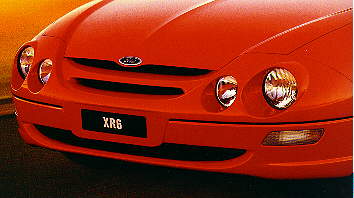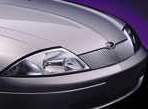|


continued

 Above The 1999 Ford Fairmont Ghia. There are hints of Lincoln around the rear, but the New Edge theme is apparent with the lights and novel (for this class) proportions. Right The station wagons play with edgy forms as well - note the rear window shape in relation to the lights - although there is a clearer link to their predecessors. This is not because of carryover panelwork, but the body-colour C-pillar, introduced in 1988 to provide the Wagon's glasshouse with more visual strength.
Above The 1999 Ford Fairmont Ghia. There are hints of Lincoln around the rear, but the New Edge theme is apparent with the lights and novel (for this class) proportions. Right The station wagons play with edgy forms as well - note the rear window shape in relation to the lights - although there is a clearer link to their predecessors. This is not because of carryover panelwork, but the body-colour C-pillar, introduced in 1988 to provide the Wagon's glasshouse with more visual strength.
On September 3, Ford's Australian outpost attempted to steal the thunder back. Ford has taken the New Edge design philosophy to the new Falcon and Fairmont, resulting in a more adventurous shape, although less so than Ford's Ka, Puma, Focus or the Mercury Cougar.
Spy photos published a few years ago mistook the new Falcon for the upcoming Jaguar XS6 - the cars appear luxurious, and accomplish this with a minimum of ornamentation.
The genius of this newer design is in the details. While the overall effect of the Falcon is rounded, elements, such as the front and rear lights, have sharp angles which keep the eye entertained.
During the 1980s, with an emphasis on aerodynamics, there was a danger that everyone would adopt the form of the Audi 100, the first aero-look sedan which paved the way for the 1982 Ford Sierra/Merkur XR4Ti and the 1985 Taurus/Sable. It was with Fiat's square-cut but aerodynamic Tipo of 1989 which showed that rounded forms were unnecessary. Opel's Calibra coupé of the same year played with subtle details - such as spoilers which seem to emerge from the platforms - and was the first to introduce an element of "visual entertainment" to the aero look.
As automobiles become less distinguishable to the everyday consumer, it has become important for manufacturers to create their own distinctive look to aid recognition. Ford calls its theme 'New Edge', a term used by global design director Claude Lobo. Not only does New Edge save on production time - the edges make the panels much easier to align - but it has provided all Ford models, beginning with the Ka and the 1997 Mondeo/Contour/Mystique, a look of their own.
In the earlier stage of the great Australian family car battle - Ford's 1988 Falcon versus Holden's 1989 Commodore - the Falcon was the more coherent design. It was all too apparent that the Commodore was an amalgam of Australian thinking and the 1987 Opel/Vauxhall Senator, to the point of sharing the doors and glass areas. The 1988 Falcon - EA26 in Ford-speak - had been, meanwhile, judged to be the most handsome of all of Ford's aero look cars by an American magazine.
Ford designers have incorporated some '96 Falcon cues, including the curve in the C-pillar which apes BMW's Hofmeister kink (everyone from Honda and Toyota to Rover and Lincoln have their own variations), but other than that the new model is a strong departure from its predecessor.
Falcon is the second big Ford to benefit from the New Edge philosophy, under an Australian team led by Steve Park. It bears interesting comparison with the 1998 Lincoln Town Car.
The general effect of the shape is similar to that of the Lincoln Town Car, but with its own distinctive look. One cannot mistake the Falcon for anything else in the Ford range.
The resemblance lies in the weight of the C-pillar and rear fenders but the Falcon breaks the monotony by having a strong waistline and emphasis at where the panels meet. The rear lights echo the New Edge theme successfully and there are clear suggestions of Ford's sports models, namely the Puma and the Cougar. The chrome above the number plate - body colour on the lower models - echo the Mondeo.
Clever design includes the ridges along the hood: chief designer Park says they are to create interesting lighting effects. A rounded, characterless shape does little with the light; the Falcon's front end is meant to play with it (and does so successfully). In fact, the ridges recall Ford's other flowing design, the 1971 Cortina Mark III, although now the effect is far more harmonious.
The Falcon's details are attractive but the car lacks balance in some areas: it looks slightly heavy where the A-pillar meets the boneline (like the Fiat Palio and Punto). Nevertheless, it is contemporary and is a logical big-car extension of New Edge design.
Ford had experimented, from the 1995 model year onwards, with having different grilles for each Falcon and Fairmont model.
|

 Above The Falcon XR6 and XR8 grille - you don't put something this aggressive on a car if you're not confident. It's very different from that of the base Falcon Forté (left), which would look at home on a Mercury sedan Above The Falcon XR6 and XR8 grille - you don't put something this aggressive on a car if you're not confident. It's very different from that of the base Falcon Forté (left), which would look at home on a Mercury sedan
|
The 1999s are the same: the base Falcon Forte has a vertically slatted grille which is more at home in the Mercury division and likely to divide traditional buyers. Higher models get more traditional, with the exception of the sports model, the XR6 and XR8.
Here, Ford designers are more daring than their Holden counterparts. The four round headlamps and body-colour nose suggest performance. This is a Ford Australia trademark, used on the 1988 Laser TX3 and in a slightly varied form, on the 1995 Laser Lynx.
In terms of body design, only Chrysler's Concorde/LHS/300M/Dodge Intrepid rival the Falcon and show what could be possible by playing with soft and hard forms. The 300M is particularly elegant as an American interpretation of European styling. Not meaning to underestimate Ford's designers' efforts, the automobiles do not look as advanced as Chrysler's offerings. In Ford's defence, the new cars occupy a sector where front-wheel-drive remains unwelcome to buyers and that solidity - a requirement for non-urban Australian drivers, and the many cabbies who tend to choose Falcon over Commodore - has to be suggested in the body shape. Chrysler's cars are svelte, advanced and roomy, but do not suggest the same toughness in their æsthetics.
Marketing
From a marketing perspective, the cars are interesting as they mark the return of left-hand-drive exports from Australia. Holden is already exporting the Commodore as the Chevrolet Lumina into Middle Eastern markets. The shape itself is more pleasing than the US-market Lumina, lacking the overhangs and ornamentation which Chevrolet introduced after the death of its full-size Impala and Caprice models. However, despite all the oil the V8s are not offered. At CAP, we feel there is room for the Commodore to be sold as the Chevrolet Impala, and the stretched version the Caprice, but history has determined that won't happen for now.
Falcon, meanwhile, may also be exported to new markets. While it will not replace the European Scorpio as Ford's big car there, it could make sense as a rear-wheel-drive family sedan slotting in between Taurus and Crown Victoria, providing fleet and governmental buyers with a smart alternative. In any case, the Falcon platform will also be used at other Ford divisions, including the new-millennium retro Thunderbird for the North American market. 
Home | Contents
Features
External links
Ford Australia
General Motors-Holden's Pty. Ltd.
Chrysler
Lincoln-Mercury Division
|